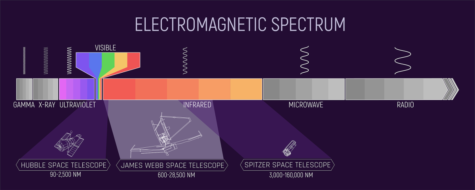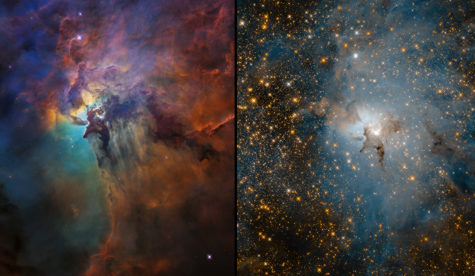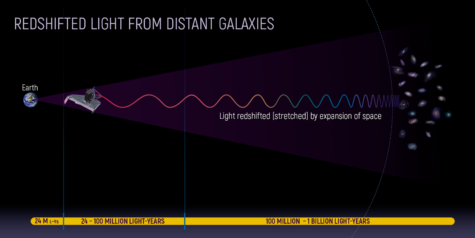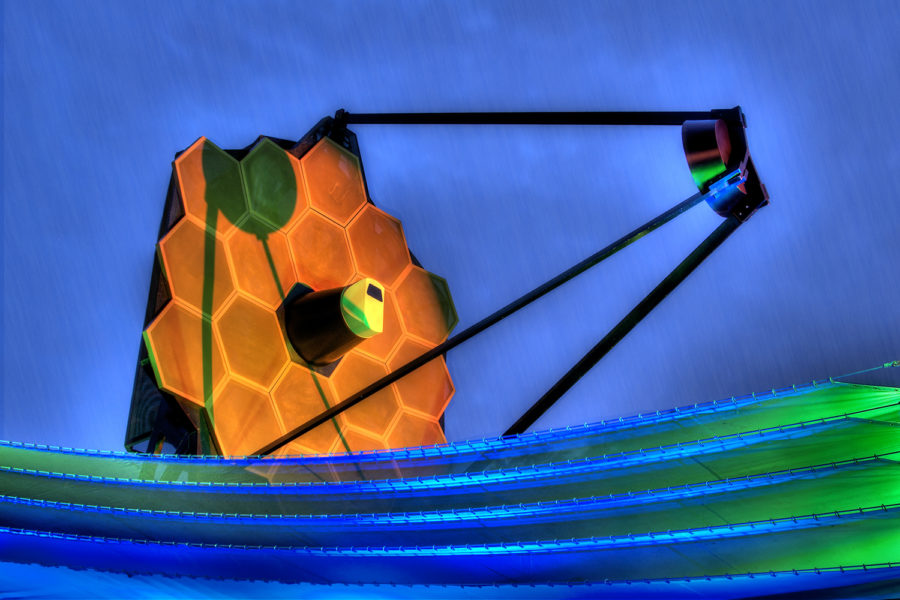Most Powerful Telescope Launches This Year
The James Webb space telescope (full scale model shown here) will be the strongest telescope ever launched.
“It will fundamentally alter our understanding of the universe,” wrote NASA about one of their projects nearing completion.
The James Webb Space Telescope (JWST) will help reveal more than we’ve ever known about our galaxy; according to NASA, it will be the most complex and strongest telescope ever launched into space. NASA plans to launch the telescope on October 31, 2021, in a rocket called Ariane 5. This day and launch will be breathtaking because, according to The Verge, a technology website, astronomers, engineers, mathematicians, and tons of others from all around the globe have worked on this telescope for more than 25 years.

(Image by NASA)
Unlike many other telescopes that collect visible light, this telescope will primarily observe space in the infrared spectrum, a primary reason why the JWST is so powerful.
Using infrared light proves to have many benefits. When light is shown in a prism, it shows a range of the rainbow colors. This is visible light, which is what humans can see.
However, to the right of that visible light sits an invisible wavelength: infrared. This has a longer wavelength than visible light, but humans can still detect it; infrared can be seen in the form of heat.
According to the James Webb Space Telescope website, there are many benefits of using infrared light.
For example, in space, stars are created in clouds of dust called nebulae. With normal, visible light, the dust would block our vision. Luckily, infrared light is able to slice through the nebulae, peering through it to see otherwise hidden objects.

Additionally, the site describes that many small bodies of matter, such as planets, are hard to detect in visible light, but because they emit heat, we can study them in the infrared spectrum.
Finally, many galaxies far away are moving away from us, so the wavelengths of their light get stretched as the light travels back to Earth. This process is called redshift. Because infrared light is a broad wavelength, the stretched-out light that was once, perhaps, visible light is often redshifted to infrared, which typical visible light telescopes cannot see, but the JWST can.

Because of all of these benefits, according to NASA, there are many functions of the JWST. For example, peering through dust clouds will explore the life cycles of stars. Because of redshift, the JWST will help us see galaxies that are extremely far away. Additionally, we will learn more about the evolution of galaxies.
Engineering Challenges
Typically, the larger the telescope’s mirror (the part of the telescope that makes an object bigger), the more precise the telescope will be. In addition, many telescopes have to escape the Earth and launch into space (to avoid the atmosphere that blocks some light out) to get the most accurate, precise images. The JWST will need to be engineered specifically to accommodate these two factors.
NASA stated that the mirrors were six times as big as Hubble’s mirrors. However, there is a problem: the mirrors are so big that the telescope cannot fit inside of the rocket, and also, the telescope might be too heavy or brittle. Luckily, there are solutions. To fit inside Ariane 5, the telescope will be folded up, and after the launch, like a transformer, will unfold. Additionally, the mirror is made of beryllium, a strong yet lightweight metal. With new technology, the JWST will explore the depths of the universe.
However, there is a slight problem with using infrared radiation. The Sun, Earth, moon, and the telescope itself all produce a little heat, infrared radiation. To only focus on the objects it wants to observe, the JWST will have a sunshield to block out the excess infrared light.

(NASA)
For this to occur, NASA stated that the telescope will launch to orbit around the L2 point in our Solar System; a point far away from Earth. Here, infrared light from the Earth, moon, and Sun can all be blocked at once; the Earth, moon, and Sun are always aligned.
According to Verge, the JWST started in 1996 and was supposed to cost $1 billion. “Since then, the scope of the project has ballooned: its total lifetime cost will be more than nine times that much, around $9.66 billion, with a launch more than a decade later than planned,” reported The Verge.
Although 25 years is a long time, Torben V., an avid astronomy fan, suggested, “It’s a very complicated project, and it is also moving out to the L2 point from earth, which is a place where it can’t be fixed.” He suggested that if there was a problem with the JWST, no one could launch all the way to the L2 point to fix it.
“I actually think the most important thing is that they get it right the first time–otherwise, all this money would be lost,” said Torben.
Galaxies, stars, nebulae, and what lies beyond these is mesmerizing. The James Webb Space Telescope, with its novel technology and infrared astronomy, will explore the four corners of the universe, hunting for thousands of hidden (for now) objects that will completely fascinate us.
Science teacher Brianna Burnett is excited about the launch and has followed its progress since she was in middle school.
“[It] pushes us toward being more definitive in what we know about the universe and about our past and honestly about the future,” she said, explaining the importance of the project.
What currently lies in the universe is now waiting to be discovered.


